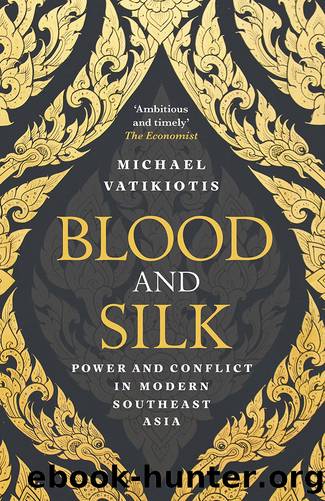Blood and Silk: Power and Conflict in Modern Southeast Asia by Michael Vatikiotis

Author:Michael Vatikiotis [Vatikiotis, Michael]
Language: eng
Format: epub
ISBN: 9781474602006
Google: SFM_DQAAQBAJ
Amazon: 1474602002
Published: 2017-06-08T04:59:32+00:00
CHAPTER EIGHT
GREED, GRAFT AND GORE
âDonât think I steal the peopleâs property, I am the prime minister for the people.â
Najib Tun Razak, Prime Minister of Malaysia
Bad politics and poor governance hold up Southeast Asiaâs progress, but driving all this like a reliable combustion engine is a pernicious culture of graft and greed. Southeast Asian countries regularly figure high up global tables measuring corruption and a lack of transparency. In 2015 Cambodia ranked 150th out of 168 countries in terms of the perception of corruption index, according to Transparency International (TI), an international watchdog. Thailand sat at 76, Indonesia at 88 and Vietnam at 112. Singapore was ranked 8 and, oddly, given the countryâs current predicament, Malaysia ranked just below 50 on the index in 2015. Such high levels of corruption are alarming in a part of the world increasingly at the centre of global finance and investment.
The comforting expectation in the 1990s was that increasing growth and investment would be accompanied by a commensurate sense of responsibility towards safeguarding the dividends. The expectation of probity increased after Southeast Asiaâs economies lost almost $10 billion in GDP during the Asian Financial Crisis of 1997. The IMF was forced to intervene with a $40 billion package to stabilise Asian currencies and there was the unforgettable image of IMF Managing Director Michel Camdessus standing with his arms folded like a colonial supervisor over Indonesiaâs President Suharto as he signed far-reaching financial reforms into law. But while the legacy of the crisis was somewhat better management of reserves, as the economist Joseph Stiglitz pointed out, the collusion between hedge fund managers and well-heeled members of the elite with their secret bank accounts continued as normal. In the years after the crisis, wherever I travelled in Southeast Asia I saw precious little evidence that any real lessons had been learned: capital flowed unhindered, and for the most part unquestioned, so that the rich got richer.
Rapacious corruption threatens not just the quality of the business environment and social stability, but also impinges on regional security. Corruption scandals affecting governments and their leaders expose them to international prosecution, and upset bilateral relationships that help balance the contest between larger powers such as China and the US, and ultimately the contest for strategic supremacy in Asia. Corruption also impedes political reform and encourages kleptocratic leaders to maintain repressive measures to protect their hold on power. Corruption is more than a troubling affliction; it is crippling Southeast Asiaâs progress.
Modern Southeast Asians have grown up in a world plagued by corruption at all levels of society. The venerable Far Eastern Economic Review reported in the mid-1970s that âtea moneyâ â under-the-table payment for goods and services â was a âway of lifeâ in the region. Sadly, it appears that, despite the passage of time, decades of reform, more transparent, representative government in some countries, and the wonders of modern media technology, little or no progress has been made â except perhaps to highlight the problems more acutely. In addition to the
Download
This site does not store any files on its server. We only index and link to content provided by other sites. Please contact the content providers to delete copyright contents if any and email us, we'll remove relevant links or contents immediately.
| Africa | Americas |
| Arctic & Antarctica | Asia |
| Australia & Oceania | Europe |
| Middle East | Russia |
| United States | World |
| Ancient Civilizations | Military |
| Historical Study & Educational Resources |
The Story of China by Michael Wood(927)
Mr. Selden's Map of China by Timothy Brook(774)
Philippines--Culture Smart! by Culture Smart!(669)
Heroic Hindu Resistance To Muslim Invaders (636 AD to 1206 AD) by Sita Ram Goel(654)
Akbar: The Great Mughal by Ira Mukhoty(650)
The Meaning of India by Raja Rao(631)
Vedic Physics: Scientific Origin of Hinduism by Raja Ram Mohan Roy(624)
Food of India by unknow(616)
Banaras by Diana L. Eck(613)
India--Culture Smart! by Becky Stephen(602)
China Unbound by Joanna Chiu(601)
First Platoon by Annie Jacobsen(599)
Mao's Great Famine: The History of China's Most Devastating Catastrophe, 1958-1962 by Frank Dikötter(594)
North of South by Shiva Naipaul(588)
Insurgency and Counterinsurgency by Jeremy Black(564)
How to Be a Modern Samurai by Antony Cummins(562)
A History of Japan by R.H.P. Mason & J.G. Caiger(561)
The Genius of China: 3,000 Years of Science, Discovery, and Invention by Robert Temple(560)
The Digital Silk Road by Jonathan E. Hillman(549)
